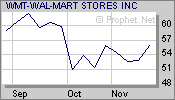
American stores are dropping prices to lure holiday shoppers; the squeeze on profit margins is apt to strangle some of them.From Yves Saint Laurent to Wal-Mart, retailers are slashing prices to mobilize America's down trodden consumers. Their paring knives are likely to cut both ways, however, drawing unprofitable traffic that will be the undoing of the weaker competitors.
Faced with rising unemployment, home foreclosures and a metastasized credit crisis, Americans and those who depend on their free-spending ways are understandably nervous— November’s consumer confidence edged up just slightly to a still dismal reading of 44.9. Black Friday, the first day of the shopping season, began with better traffic than might have been expected, but not necessarily with a lot of money being spent. (See "Scrooges Flood The Malls." )That does not bode well for the holiday shopping season. The November-December stretch is always a crucial period (many retailers, like Toys 'R' Us garner 40.0% of their year’s revenues in that window), but perhaps even more so this year, as retailers try to compensate for lackluster fall sales. In October, Neiman Marcus saw a 26.8% drop in same-store sales, J.C. Penney (nyse: JCP - news - people ) lost 13.0%, and Saks (nyse: SKS - news - people ) tumbled 16.6%. The one bright spot was discount mecca, Wal-Mart Stores (nyse: WMT - news - people ), which saw sales tick up 2.4% from the year-ago perod, on its reputation for bargain-basement prices.
Now the rest of the field is trying to mimic Wal-Mart’s black sheep success by becoming the value destination within their niche. Long before Black Friday, retailers across the board rolled out value-oriented advertisements and eye-popping discounts— while 20.0%-40.0% price reductions are typical this time of year, many have been discounting at 50.0%-60.0% off. At the ultra high-end, retailers like Hermes International (other-otc: HESAF - news - people ) have focused on classic items that can be promoted as investment pieces.
“From our perspective it’s all the more important to make sure the customer feels that we understand the pressures she’s seeing and that we have the style and quality at the price that she thinks is really smart,” Myron Ullman, chief executive of J.C. Penney, told Forbes.com. Ullman does not expect consumer spending to recover until the second half of 2009.
Needham analyst Sean McGowan said retailers have to highlight value because the crisis has triggered a fundamental shift in U.S. consumer psychology.
“People are trading down from higher-priced items to more affordable items,” McGowan said. “We’re seeing consumers holding out until they get something that makes them feel like they’re getting a deal.”Retailers could deliver an upside surprise in November sales as consumers flock to take advantage of what seem like great deals. But if they really are great deals, that will punish the stores' profit margins. The weak are unlikely to surive.
“This value message is going to persist,” McGowan said. “There’s been a discussion for quite a number of years of how overstored America is. A lot of the retailers acted like a lot of the consumers did, they were buying unleveraged, living beyond their means. I think we’ve just begun to see a wave of a lot of closings. We’ll see probably many thousands of stores close in 2009.”
No comments:
Post a Comment